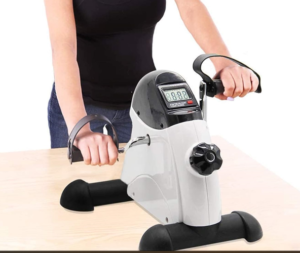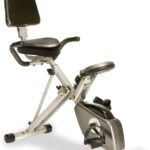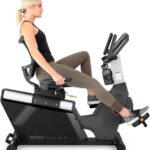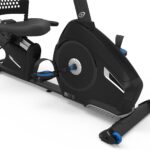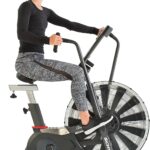Exercise bikes have changed the way many of us think about exercise. Whether you’re a fitness Pro or just starting, the appropriate workout equipment may make or break your trip. Two common indoor cycling options stand out: the mini exercise bike vs full size exercise bike.
Choosing between the two isn’t just about size or appearance; it’s about determining which best fits your lifestyle, goals, and available space. This guide aims to unravel the unique qualities of both types, ensuring you make an informed decision that complements your fitness aspirations.
Mini Exercise Bike vs Full Size: A Comprehensive Comparison
Physical Differences & Key Features
Understanding the physical characteristics of fitness equipment, particularly exercise bikes, will help you make the right pick. Let’s look closer at the distinct features of the mini and full-size exercise bikes.
Full-Size Exercise Bikes:
Design and Structure: Full-size exercise bikes, unlike conventional bicycles, stay in a single spot, indicating that they are stationary. They often include a large seat, handlebars, and a screen or dashboard to track progress. The frame is strong and designed to withstand strenuous workouts.
Resistance Types: Adjustable resistance is one of the most important characteristics of full-size bikes. It allows you to simulate cycling uphill, flat routes, or even down slopes. Several resistance systems, such as magnetic, flywheel, and friction, provide varying training intensities.
Mini Exercise Bikes:
Compactness and Design Benefits: The mini exercise bike is all about space-saving. It’s compact, light, and easy to transport. The majority of versions lack handlebars and a seat. They only have the pedal mechanism, which can be positioned beneath desks or in front of chairs.
Resistance Functionalities: Despite their small size, many mini bikes provide adjustable resistance. It allows customers to adjust the difficulty level, assuring a customized workout. For this purpose, some types employ tension belts or magnetic resistance.
When choosing between these two types of bikes, consider what you prioritize more: a comprehensive cycling workout or the convenience of exercising anywhere. Both offer advantages and understanding the physical differences between them can be the key to your exercise success.
Read: Exercise Bike Magnetic Vs Belt Drive
Suitable Uses & Ideal Scenarios for Mini Exercise Bike vs Full Size

Both the mini and full-size exercise bikes are excellent tools for fitness, but they shine in different scenarios. Let’s explore where each type of bike fits best.
Full-Size Exercise Bikes:
- Intensive Cardiovascular Workouts: Full-size bikes are perfect if you want to break a sweat and get your heart rate up. They simulate real cycling experiences, providing a thorough cardiovascular workout, which is great for heart health.
- Training for Events: Are you preparing for a cycling race or a triathlon? These bikes can help mimic real road conditions, enabling you to train effectively without stepping outside.
- Dedicated Home Gyms: A full-size bike can be an excellent addition if you have a fitness room or a specific space for exercise at home. It’s a focal point in many home gyms, offering various workout programs.
Mini Exercise Bikes:
- Office Workouts: One of the standout benefits of mini bikes is the ability to use them at work. Place them under your desk and pedal away while attending meetings or answering emails. It’s a seamless way to integrate fitness into your workday.
- Multitasking: Whether you’re watching your favorite show, reading a book, or simply relaxing, you can still exercise. The mini bike’s design is perfect for those who want to stay active without dedicating specific workout time.
- Rehabilitation: For individuals recovering from injuries, especially leg or knee-related ones, the controlled and gentle movement of mini bikes can be beneficial. It allows for low-impact exercise, aiding in quicker recovery.
- Travel and Portability: Going on a trip but don’t want to miss out on your fitness routine? The lightweight and compact nature of mini bikes makes them travel-friendly, allowing you to maintain your exercise regimen.
In essence, the best bike for you depends on your needs. Are you aiming for high-intensity workouts or seeking a convenient way to stay active throughout the day? Your lifestyle, goals, and available space will guide your choice.
Health Benefits & Fitness Outcomes of Mini Exercise Bike vs Full Size
Both mini and full-size exercise bikes provide health benefits, but the scope and intensity of these benefits can vary. Let’s explore the health rewards each type of bike offers.
Full-Size Exercise Bikes:
- Greater Range of Motion: A full-size bike engages more muscle groups, from your core to your calves. This extensive range of motion translates to a more comprehensive workout, helping tone and strengthen various muscles.
- Higher Calorie Burn Potential: These bikes can aid in weight management due to the intensity and full-body engagement. They typically burn more calories per session than their mini counterparts, making them ideal for weight loss goals.
- Cardiovascular Enhancements: Regular use of full-size bikes can improve heart and lung health. They boost cardiovascular endurance, ensuring a healthy and robust heart.
Mini Exercise Bikes:
- Consistency Leads to Results: The convenience of mini bikes means they can be used more often, even in small durations. Over time, consistent light activity can accumulate significant health benefits.
- Light Aerobic Activity: Mini bikes offer a gentle yet effective way to increase blood circulation and improve joint mobility. This type of light aerobic exercise is especially valuable for seniors or those starting their fitness journey.
- Lower Body Strength: While they might be compact, mini bikes effectively target the muscles of the lower body. Regular use can lead to stronger thighs, calves, and glutes without placing undue strain on the joints.
Read: Pedaling Backward on a Spin Bike
Frequently Asked Questions (FAQs)
1. Can a mini exercise bike help me lose weight?
Absolutely! While mini exercise bikes may not burn as many calories in a single session as full-size bikes, regular use and incorporating them into your daily routine might help you lose weight over time. Remember that consistency and devotion often lead to success.
2. Is investing in a full-size bike worthwhile if I have limited space?
It depends on your priorities. If you enjoy intense workouts and have a dedicated space for the bike, it can be a worthwhile investment. If space is an issue, try foldable models or a mini exercise bike that allows for placement flexibility.
3. How do I determine which bike type is right for me?
Assess your goals (weight loss, toning, rehabilitation), space constraints, and preferred workout intensity. A full-size bike would be appropriate if you want to do high-intensity workouts and have the space. On the other hand, a mini exercise bike can be a fantastic fit for individuals looking for a convenient workout choice that fits into their daily schedule or needing a portable solution.
Conclusion:
In the ever-changing fitness landscape, the choice between mini vs full size exercise bikes is based on personal needs and ambitions. While the full-size bike provides an intense, gym-like experience for people looking to lose weight and improve their cardiovascular health, the mini bike stands out for its mobility, ease, and adaptability to various venues such as offices or living rooms. It is a one-of-a-kind asset due to its adaptability for modest cardio workouts and recovery.
Understanding these various aspects is critical for people planning their fitness journey. By matching your space, ambitions, and interests with the appropriate bike, you are investing in equipment and a healthier future.
